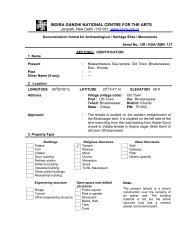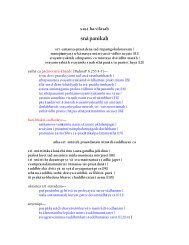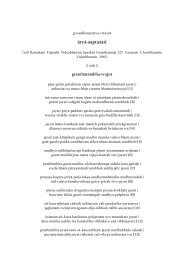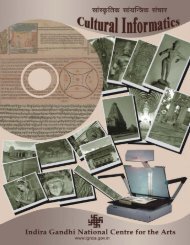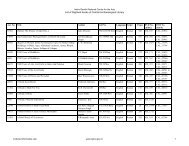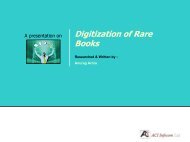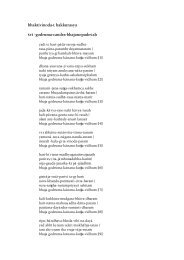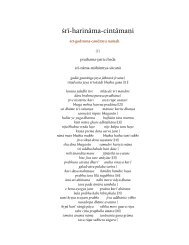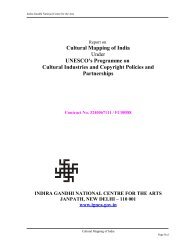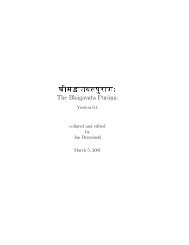KRISHNA REDDY : A RETROSPECTIVE AT IGNCA Concept Note ...
KRISHNA REDDY : A RETROSPECTIVE AT IGNCA Concept Note ...
KRISHNA REDDY : A RETROSPECTIVE AT IGNCA Concept Note ...
You also want an ePaper? Increase the reach of your titles
YUMPU automatically turns print PDFs into web optimized ePapers that Google loves.
<strong>KRISHNA</strong> <strong>REDDY</strong> : A <strong>RETROSPECTIVE</strong> <strong>AT</strong> <strong>IGNCA</strong><br />
<strong>Concept</strong> <strong>Note</strong>/Overview:<br />
The Retrospective Exhibition titled In Search of the Unknown: The Art &Life of Krishna<br />
Reddy to be held at the <strong>IGNCA</strong> in November 2011, marks the journey of Krishna Reddy<br />
as an artist, taking us through various locations that became instrumental in developing<br />
his unique position as an internationally acclaimed Indian artist and a pedagogue who<br />
has contributed to art education for more than fifty years.<br />
Born in 1925 in Chittoor in Andhra Pradesh, Krishna Reddy went to Santiniketan to<br />
study Art under the master guru Nandalal Bose. Later, with the help of J. Krishnamurthi<br />
(who remained a lifelong friend), he travelled to Europe where he spent his most<br />
impressionable years in London, France, Rome and Milan, studying Sculpture and<br />
working with Henry Moore, Ossip Zadkine and Mario Marini. He also had intimate<br />
contacts with great artists such as Brancusi and Giacometti, and all these encounters had<br />
a profound impact on his work. Ossip Zadkine introduced Krishna Reddy to Stanley<br />
William Hayter, a formidable innovator and printmaker who had founded the widely<br />
influential print studio - Atelier 17 in Paris in 1927.
It is at Atelier 17 in the early 1950s that Krishna Reddy through his experimental rigour,<br />
endless adventures and tremendous patience arrived at the most important developments<br />
in his printmaking techniques. It was here that he began to experiment with colour<br />
viscosity printmaking - a process that was to revolutionise intaglio printing and ensure<br />
his place in the world history of Graphic Arts. The discovery that numerous colours<br />
could be printed at one time on a single plate was his greatest achievement in the area of<br />
print making and a boon to all creative printmaker artists all over the world. Reddy<br />
eventually joined Hayter as co-director of Atelier 17.<br />
Trained as a sculptor, Krishna Reddy worked on the plate like a sculpture, carving<br />
contours of relief with tools in addition to etching with acid. He worked with a variety of<br />
hard to soft rollers, rolling out one colour of ink at a time. As each ink was possessed of a<br />
particular viscosity, Krishna Reddy showed that several colours could be superimposed,<br />
yet kept at different levels of the etched and carved plates. Thus some colours would<br />
mix, while others would repel one another. This technical breakthrough effectively<br />
eliminated the need to print one colour on the plate at a time, allowing the artist greater<br />
freedom and control over his work.<br />
One of the most significant Indian artists widely respected both in the East and the West,<br />
Krishna Reddy besides winning many other awards, has been honoured with a "Padma<br />
Shri" in recognition of his significant contribution to contemporary Indian art.<br />
It is important to stress here that though Krishna Reddy has been residing outside India<br />
for more than five decades, His work and life has been consistently shaped by his early<br />
formative years in India and the integrated philosophy of life, where nature and culture<br />
are not perceived as binaries but co-exist in enriching the experience of the cosmos, the<br />
universe that is the utmost gift to mankind.<br />
Curatorial Plan:<br />
The Retrospective Exhibition intends to do the following :<br />
1. Through the designed display plan, we intend to highlight the historical<br />
landmarks of Reddy’s artistic journey.<br />
2. We would give emphasis to his early years and learning in Santiniketan, his<br />
movement to the South and then to London, Paris and New York, amalgamating<br />
artistic learning, bringing together East and West sensibilities to arrive at his<br />
distinct imagery.<br />
3. The exhibition will highlight the attitudes of science and art, two streams of<br />
consciousness embedded in his printmaking via his philosophy and processes. For<br />
instance, how the mysteries of Nature and cosmic rhythms are observed and<br />
distilled in the structuring of his visual form.<br />
4. Images and text will be interfaced throughout the exhibition to make it<br />
educational and to evoke meanings for the viewers to engage with.<br />
5. His work in various techniques- sculpture, drawing, etching, watercolour and<br />
viscosity will all be juxtaposed in places to highlight his recurring themes and<br />
preoccupations with the visual image.
6. Archival material in terms of letters, quotes from eminent artists and writers, his<br />
colleagues from the West, his personal photographs will all be put on display in<br />
designed vitrine boxes and pedestals.<br />
The exhibition will be the first of its kind in paying its tribute to a contemporary master-<br />
artist who has sustained his passion and commitment to art and education for more than<br />
sixty years, initiating a dialogue between the East and the West around the making and<br />
viewing of Art.<br />
Roobina Karode<br />
Curator, Krishna Reddy Retrsopective



